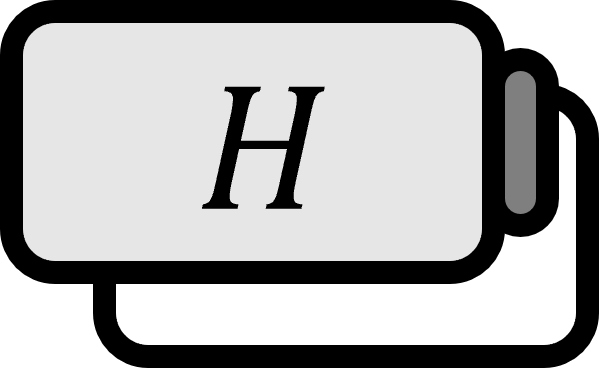Self-adjoint Operator
Definition
Given a Hilbert space $H$ and a bounded linear operator $T : H \to H$, if they satisfy the following, it is called a self-adjoint operator.
$$ T^{\ast} = T $$
$T^{\ast}$ is the adjoint operator of $T$.
Explanation
If it is self-adjoint, it is a normal operator $(T^{\ast}T = TT^{\ast})$. Rewriting the defining condition yields the following.
$$ \braket{T \mathbf{x}, \mathbf{y}} = \braket{\mathbf{x}, T \mathbf{y}}, \qquad \forall \mathbf{x}, \mathbf{y} \in H $$
In finite dimensions, i.e., viewed as matrices, $T^{\ast}$ is the conjugate transpose matrix of $T$, and a $T$ satisfying $T^{\ast} = T$ is called a Hermitian matrix. In other words, a self-adjoint operator is a generalization of a Hermitian matrix.
Properties1
Let $H$ be a Hilbert space and $T, S : H \to H$ a bounded linear operator. Then the following hold.
(a) If $T$ is self-adjoint, then for all $x \in H$, $\braket{T\mathbf{x}, \mathbf{x}}$ is real.
(b) If $H$ is a complex vector space and for all $x \in H$ $\braket{T \mathbf{x}, \mathbf{x}}$ is real, then $T$ is self-adjoint.
(c) For two self-adjoint operators $S$ and $T$, $ST$ is self-adjoint if and only if $S$ and $T$ commute (commutability). $$ ST \text{ is self-adjoint} \iff ST = TS \text{ (for self-adjoint $S$ and $T$)} $$
(d) Any bounded linear operator $T : H \to H$ and its adjoint can be uniquely expressed as a linear combination of two self-adjoint operators $T_{1}$ and $T_{2}$. $$ T = T_{1} + iT_{2}, \qquad T^{\ast} = T_{1} - iT_{2} $$ Here $T_{1}$ and $T_{2}$ are given respectively by: $$ T_{1} = \frac{1}{2}(T + T^{\ast}), \qquad T_{2} = \frac{1}{2i}(T - T^{\ast}) $$
Proof
(a)
Assume $T$ is self-adjoint. By the definition of the inner product and the definition of self-adjointness, we have:
$$ \overline{\braket{T \mathbf{x}, \mathbf{x}}} = \braket{\mathbf{x}, T \mathbf{x}} = \braket{T \mathbf{x}, \mathbf{x}}, \quad \forall \mathbf{x} \in H $$
Therefore $\braket{T \mathbf{x}, \mathbf{x}}$ is real.
■
(b)
Since a real number equals its complex conjugate, by the definition of the adjoint and the inner product we have:
$$ \braket{T \mathbf{x}, \mathbf{x}} = \overline{\braket{T \mathbf{x}, \mathbf{x}}} = \overline{\braket{\mathbf{x}, T^{\ast} \mathbf{x}}} = \braket{T^{\ast} \mathbf{x}, \mathbf{x}}, \quad \forall \mathbf{x} \in H $$
Then we obtain:
$$ \braket{T \mathbf{x}, \mathbf{x}} - \braket{T^{\ast} \mathbf{x}, \mathbf{x}} = \braket{(T - T^{\ast}) \mathbf{x}, \mathbf{x}} = 0, \quad \forall \mathbf{x} \in H $$
For a complex vector space $X$, if $Q : X \to X$ satisfies $\braket{Qx, x} = 0$ for all $x \in X$, then $Q = 0_{\text{op}}$.
Then by the property of the zero operator the following holds, and $T$ is self-adjoint.
$$ T - T^{\ast} = 0 \implies T = T^{\ast} $$
■
(c)
The adjoint of a product is $(ST)^{\ast} = T^{\ast}S^{\ast}$, and assuming both operators are self-adjoint we obtain:
$$ (ST)^{\ast} = TS \tag{1} $$
Assume $ST$ is self-adjoint. Then the following holds.
$$ (ST)^{\ast} = ST \tag{2} $$
From $(1)$ and $(2)$, $TS = ST$ follows.
■
Let $(\impliedby)$ $ST = TS$. Then by $(1)$ the following holds.
$$ (ST)^{\ast} = TS = ST \implies (ST)^{\ast} = ST $$
Therefore $ST$ is self-adjoint.
■
(d)
First, it is easy to see that $T_{1} = \frac{1}{2}(T + T^{\ast})$ and $T_{2} = \frac{1}{2i}(T - T^{\ast})$ are self-adjoint.
$$ \begin{align*} \Braket{\frac{1}{2}(T + T^{\ast})x, y} &= \Braket{x, \left[ \frac{1}{2}(T + T^{\ast}) \right]^{\ast}y} \\ &= \Braket{x, \frac{1}{2}(T^{\ast} + T)y} \\ &= \Braket{x, \frac{1}{2}(T + T^{\ast})y} \end{align*} $$
And,
$$ \begin{align*} \Braket{\frac{1}{2i}(T - T^{\ast})x, y} &= \Braket{x, \left[ \frac{1}{2i}(T - T^{\ast}) \right]^{\ast}y} \\ &= \Braket{x, \overline{\frac{1}{2i}}(T^{\ast} - T)y} \\ &= \Braket{x, \frac{1}{2i}(-T^{\ast} + T)y} \\ &= \Braket{x, \frac{1}{2i}(T - T^{\ast})y} \end{align*} $$
That $T = T_{1} + iT_{2}$ and $T^{\ast} = T_{1} - iT_{2}$ is obvious.
■
Erwin Kreyszig. Introductory Functional Analysis with Applications (1978), p203-207 ↩︎
